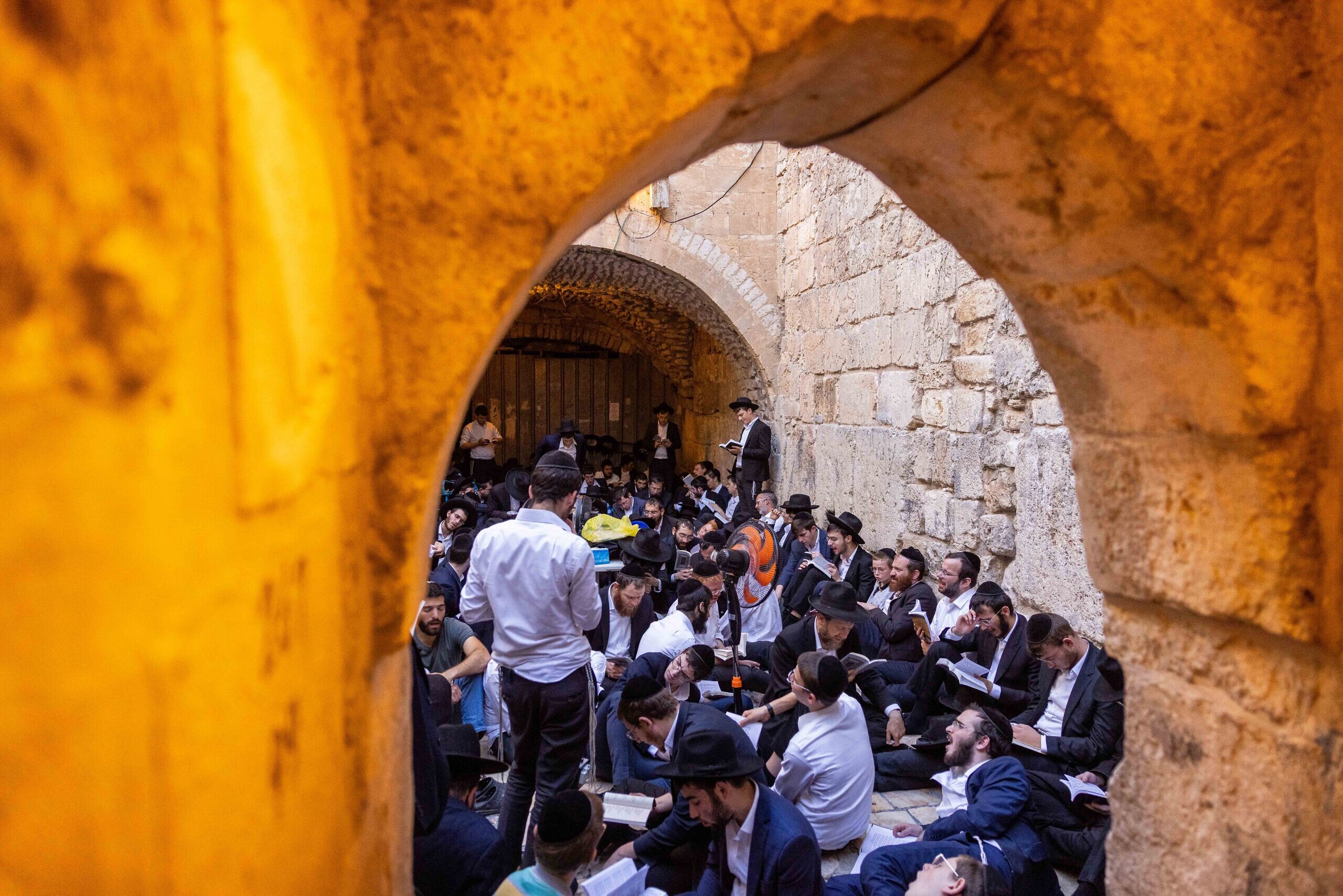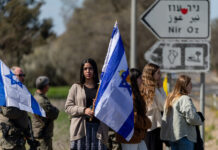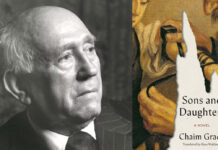One of the images in a mournful poem by the seventh-century rabbi Eleazar ben Kalir, which is a central kinah prayer chanted on the Tisha B’Av fast day, refers to the silenced words of Temple singers.
Giving literary form to unspeakable tragedy has been a central preoccupation of trauma writing for centuries, and it is also very contemporary. Since the Hamas terrorist attacks on southern Israel—the bloodiest day in Jewish history since the Holocaust—Jews have tried to express what they are feeling. Ahead of the nearly 25-hour fast day of Tisha B’Av, which begins this year on Monday night, two prominent rabbis told JNS about kinot prayers that they composed.
Rabbi Moshe Hauer, executive vice president of the Orthodox Union, penned a kinah that he modeled on an existing one typically numbered 25 in kinot collections. He estimates that he used between 60% and 70% of the original paragraphs, and within those, he changed one-third of the words at most.
“This is not total creative writing. This is taking something which existed, which is rich, which is deep, which is beautiful, which was authored almost 1,000 years ago,” Hauer told JNS, adding that he used “that frame to wrap around the current tragedy and the current events.”
A former senior rabbi of 26 years at Bnai Jacob Shaarei Zion Congregation in Baltimore, Hauer isn’t sure if he will recite the prayer this holiday, which took him an hour to an hour-and-a-half to compose. He told JNS that he still leads kinot at his old congregation but will defer to the current rabbi about what prayers he does and does not chant publicly.
“I assume that he will want it, but I’m not going to make a decision,” he said.
‘Much more leeway’
While prayer was “more or less canonized and closed early on, whether in the time of the Second Temple or the time of the Gaonim,” which spanned from the sixth to 11th centuries, there is “much more leeway” when it comes to composing kinot, according to Hauer.
“Some have it frozen back several hundred years, but the vast majority of Orthodox communities have the kinah composed about the Holocaust, within the past 50 years,” he told JNS.
There are several kinot that commemorate the Holocaust, he added. “Everybody says one,” he said. “Kinot have that greater latitude, flexibility—we understand that we have to bring the grieving of old and update it with more current tragedies.”
Still, Hauer told JNS, he is “personally incredibly, incredibly cautious about writing new prayers.”
“I never did it before. It’s a strange turn of events that made me do it now,” he said. “Seeing how people wrote these prayers in the past—there’s such respect for what they did and how they did it, and the delicacy of the language and the spirit that went into it that I am very conservative about it.”

‘Copy of a conversation’
Rabbi Yosef Blau, senior mashgiach ruchani (spiritual adviser) at Yeshiva University, told JNS that writing new kinot “as a response to the events of Oct. 7 is a continuation of the writing of new kinot after the Holocaust.”
“It reflects both the need to give expression to the event within a traditional framework and a sense that the Hamas attack has great significance,” Blau said.
Avraham Bronstein, the rabbi of the Hampton Synagogue in Westhampton Beach, N.Y., told JNS that writing kinot for contemporary events “shows a desire to place what people are feeling now in a religious-historical context.”
“It is to say that they feel the events of Oct. 7 are part of a pantheon of historical calamities that the Jewish people have endured. My sense is that it means that there is a recognition that Oct. 7 was especially and uniquely terrible and impactful,” he said. “Seeing the desire to express what happened on Oct. 7 in the language of kinot means borrowing and shaping language that was previously used to describe the Crusades, various pogroms, the Holocaust and the destruction of Jerusalem.”
That borrowing, in one sense, validates how terrible Oct. 7 and “in a different sense, it is almost a bit of comfort, as if to say that the Jewish people have a language to describe what happened, how we feel about it and a way for the memory of what happened to be perpetuated,” according to Bronstein, who is aware of kinot recited for the Second Intifada and the for the disengagement from Gaza.
“There are probably some places that still recite them, but I don’t think they really caught on,” he said. “Time will tell as to whether any written for Oct. 7 will become part of a regular order or liturgy or if they are more a tool we are using to express our feelings in this moment.”
Hauer cited statements by Rabbi Joseph Soloveitchik, known as the Rav, who had very strong feelings about not composing new prayers. In a published collection of the Rav’s teachings about Tisha B’Av, Soloveitchik notes that “of course, the six million Jews deserve to be eulogized on Tisha B’Av,” but directs doing so by swapping new names of places in an existent kinah for old ones, as communities devastated by the Crusaders.
“It does not make much difference because the scenes described and the words of despair, mourning and grief are the same,” he said. “We must remember that what is described there happened not only then, in 1096, but in the 1940s.”
The Rav noted an “imitation” of a kinah penned about the Holocaust, which some Israeli rabbis accepted. “I do not like new ‘prayers.’ I cannot use it because, in my opinion, there is no one, no contemporary, who has all the qualities indispensable for writing prayers,” he said. “In general, I do not trust anyone who tells me he intends to compose a prayer.”
Rather than being “just a hymn,” prayer is a “copy of a conversation” between God and people, according to the Rav. “Who can write such a conversation? Only the Men of the Great Assembly and the prophets were able to do it,” he said. “Not that I, God forbid, have anything against the author of a contemporary kinah. I just do not believe that a contemporary has the inner ability, the faith, the depth, the sweep of experience, the ecstasy and the taharat ha-nefesh, the purity of soul, that would authorize him or give him permission to write a piyut,” a prayer.
Hauer told JNS that his approach to the kinah he penned is “very conservative.”
Crying but not weak
Rabbi Yosef Zvi Rimon, nasi (president) of World Mizrachi Movement, chief rabbi of Gush Etzion and rosh yeshiva at Jerusalem College of Technology, also penned a new kinah about Oct. 7.
“I did not write a kinah in the past,” he told JNS, though he has penned other prayers, including a Yom Kippur one on behalf of singles to find partners as well as a prayer for unity. He also wrote a prayer to be said during the Passover seder.
Rimon told JNS that he wanted his kinah to be a poem that flowed, and he composed it in “a very correct system of writing kinot.”
In one line, he adapts a biblical line that refers to the world filling with chaos (hamas), adding a letter to make it “Hamas.” JNS asked the rabbi about several apparent biblical references.
“I tried to speak about Hamas in a few ways,” Rimon told JNS. He added that the kinah refers to verses from Tanach, as well as some based on the Midrash.
A reference to the latter, he said, comes in his fourth stanza, where he writes, “My beloved went down to the scented flower beds/Roses were murdered, a desecration of God’s name.” The Midrash says about the verse that God takes the righteous with Him, so the murdered roses are “a clue for feeling that good people were killed in this way,” he said.

“One of the things that I wanted to transfer in the kinah was that on the one hand, a crying—things are terrible, people that were killed, and the hostages, and injured, and we have to cry,” Rimon said. “All the terrible things that have happened on Simchat Torah, on Oct. 7.”
At the same time, he told JNS, one has to remember that a sanctification of God can begin in the same manner as a desecration.
“Our heroes, our nation—that in this war we discovered more than ever that we have the best nation in the world, the best soldiers in the world and to feel all the time the balance between those two things,” he said. “On one hand, we are crying. On the other hand, we remember all the time that we are in redemption.”
“We are crying. We are sad. We are worried, but we are not weak,” he said, and with Divine help, “we are going to win together.”
‘A cry of faith’
Hauer, who is close with Rimon and shared his kinah with the Israeli rabbi, aimed to achieve a similar balance in his prayer, which is more accessible by design than Rimon’s more literary and complicated kinah.
The Orthodox Union executive sought to capture “not just a cry but a cry of faith,” he told JNS. He began, in the way he does on every writing project, “which is to pray for help.”
The first and only kinah he thought to adapt was the one upon which he settled, and he knew that he wanted to touch on elements of the Oct. 7 tragedy, the ongoing struggle, the “remarkable strength, heroism and sacrifice” of the soldiers, the hostages and their families and “the demonization of the Jewish people,” he said.
“That’s a big thing for us,” he said. “Tisha B’Av is about glorifying God’s presence in the world—the loss of that—and when the Jewish people are depicted as genocidal and unethical and ‘indiscriminate bombings’ and things like that, that’s a real Tisha B’Av source of pain.”
“On Tisha B’Av, we roll in generations of tragedy not to make us depressed. It’s the opposite. It helps us contextualize what we are experiencing now.”
Rabbi Moshe Hauer
“Rabbi Rimon’s is magnificent, and it’s filled with more allusion and poetry,” he said. “He said to me that ‘the one I wrote is for the very familiar,’ and he encouraged me to publish this one more widely.”
Hauer thinks that some Orthodox congregations will stick to the book of prior kinot and won’t recite new ones, but that doesn’t mean that Oct. 7 won’t be on their minds.
“I don’t think there’s going to be a shul where Oct. 7 isn’t mentioned. Whether they’re going to have a formal part of a new prayer, a new kinah said, there is where the variation will be. But that it will be in the background and the foreground and invoked,” he said. “I bet there’s not going to be a shul where that doesn’t happen.”
The word “unprecedented” is often invoked improperly, he thinks, when discussing Oct. 7.
“The truth is there is no ‘unprecedented’ in Jewish history, and the story of Tisha B’Av and the litany of events in our history that we remember on Tisha B’Av remind us that there is nothing that is unprecedented—even what we are going through now,” he said.
“On Tisha B’Av, we roll in generations of tragedy not to make us depressed. It’s the opposite,” he said. “It helps us contextualize what we are experiencing now. It helps us understand that we have been down these roads before and that we are here to tell the tale.”
He added: “We’re going to get past this like we got past everything else.”


























